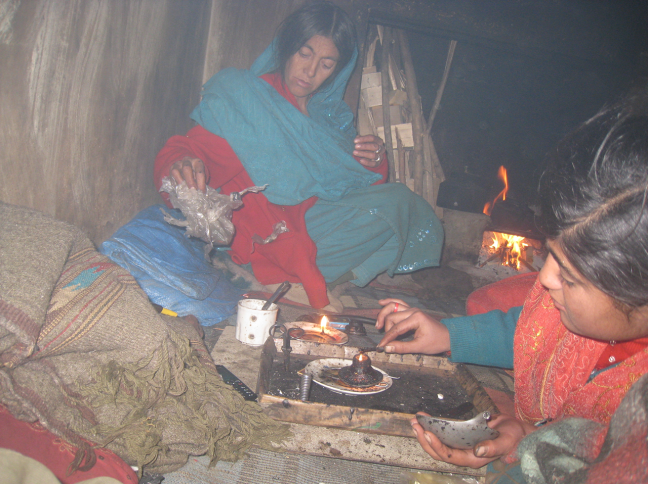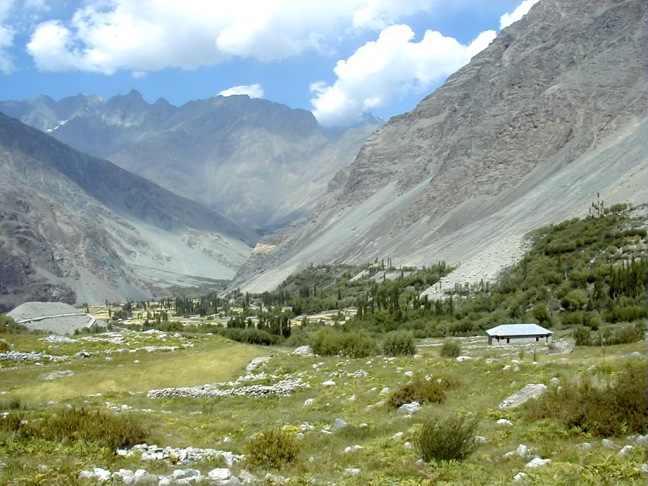The mystical valley of Broghil (also called Bam-e-Duniya the roof of the world) is located in the extreme northeast of ____ 250 km form tha nearest large city of Chitral. Broghil valley sits at 11000 ft and rises to 14121 ft at upper reaches of the hospitable or pasture land. The valley is characterized by snow clad peaks; huge glaciers, lash green meadows, vast plains of peats, unique wetlands and deep reverine valleys. The valley is undulating – varying in altitude and span considerably. Forests are scare and are found in limited and scattered patches in the lower parts of the valley which are located at low altitude. Glaciers fill the upper reaches of Broghil valley.
The Boroghil River originates from Chiantar Glacier and dominates the valley, bisecting it in two. Six villages of Broghil valley are located on the eastern bank of the river while the rest six are on the western bank.
Due to difficult geography, lack of communication means (roads, telephones etc) and extremely low literacy the valley is haunted by extreme poverty and other social evils like high rate of opium addiction both among men and women. This further adds to the local miseries. Household economy is crippled due to opium addiction and bulk of the hard earn money is consumed for opium purchase. The opium addiction, as per community perception, in the area is primarily attributed to a number of socio-ecological and cultural factors including geographic isolation of the valley, lack of recreation opportunities during leisure time, harsh climatic conditions, demanding work and to some extent as sex stimulator (local perception).
Due to its location above tree line and harsh climatic conditions agricultural activities are limited.
Broghil valley has a harsh climate. It is freezing cold during winter. While in summer (July to the end of September) the weather remains mild to cold. Temperature often remains below freezing point during the winter spell. Precipitation is mainly received in snow form from October to the end of May. Summer rains are scanty. Harsh climatic conditions in times lead to natural calamities including damages to agricultural crops, livestock and other resources. The weather is highly unpredictable as used to be with high alpine regions.
The valley is comprised of 12 small hamlets/villages of about 200 households of some 1600 souls.
In Baroghil Valley Chitral, home is the opium den for women and children braving cold
They are not ‘junkies’ or a group of friends, but family members smoking opium on a freezing cold evening in Baroghil Valley — a small town situated in the extreme north of Khyber Pakhtunkhwa’s Chitral district.
A traditional chillum (pipe) is passed from one member to another — including children — as they hunker on their knees, while thick smoke permeates the main room in one of Baroghil’s households.
In case of Broghil valley opium addiction is the worse social evil. Opium addiction is one of the main health and social nuisance of the area. The opium form of dried poppy fruit botanically opium is known as Papaver somni-ferum which is available in chocolate colored gum form prepared by drying the poppy fruit milk on a cotton cloth in the hot sun. Since ancient times, opium used by the inhabitants of Wakhan corridor and adjacent areas as pain killer, reduce bleeding and allay apprehension and exhaustion during war and hardworking times. It was also used since long as a mind altering drug and as an analgesic on the indo-Pakistan sub-continent as reported by (Dwarakanath 1965; Kohli 1966).
Opium use finds social sanction and it is not considered as an evil. In Broghil valley the underlying reasons for opium addiction, as listed by the local community members during focused group discussions, are as follow:
- Lack of access to health facilities and medicines
- Harsh climatic conditions
- Lack of other healthy and leisure activities
- Geographic isolation
- Lack of health facilities
- Need for stimulation for hard work
- Sexual enhancement for newlyweds that then leads to addiction
- Ignorance and lack of awareness
When one of the female addicts were enquired why they started using opium, majority blamed their male counterparts and the geographic confinement of the area.
We are at their mercy (pointing towards males). They feed us, protected us and provide us basic needs of life and as such we have to obey them and shape our lives what they want us to be. What can we do else, we are surrounded by high mountains all around and our lives are confined to these mud filled houses, responded a 35 years old addict woman during the discussion. When will fell ill no medicine is available to reduce the pain. My husband use opium on daily basis. In the initial stage I use to sit by him and slowly I also started using it as it not only reduce my physical suffering but also minimized the lethargy I was suffering from. This is the whole story. Now I want to quit but it is painful. My 14 years old daughter who was suffering from abdominal pain has also started using opium. Now after three month use she has also got addicted to it. It is really very expensive
Newborns of the addicted families start their lives having already opium in their bloods. Thus they are born addicts. Practically they start taking opium when they get to the age of ten and above while grazing their herds in wild. Opium is traditionally smoked in the area, in a mixed group of both male and female. They sit in a circle inside the house to take opium in turn one by one. It takes at least two hours to complete one sitting. This joint smoking also affects the other family members who are not addicts indirectly as well and with passage of time they also start using opium.
The majority of the addicts are between 35 and 70+ years old. However, an alarming number of young addicts below 18 years of age is becoming prevalent. Women account for almost 30% of the addicted population.
The communities are pleading for help.
The damaging impact of opium on health and economy has made the locals realize the repercussion of opium addiction. There is a growing realization about the hazardous impact of opium on health, household economy and social value of the addict person. But the chronic addicts are the point of no return. They have not the finances to treat themselves.
We can help. Will you join us in this mission?


